- Home
- Timothy Egan
The Good Rain: Across Time & Terrain in the Pacific Northwest Page 14
The Good Rain: Across Time & Terrain in the Pacific Northwest Read online
Page 14
Tobey’s disgust became fighting words. The Downtown Seattle Association wanted to tear down the century-old Pike Place Market, heart and soul of the city and Tobey’s favorite hangout, and replace it with a ritzy mall. They had their eyes on Doc Maynard’s old plat, the century-old stone buildings of Pioneer Square, as bulldozer fodder. Both were saved by a vote of the citizens.
Land is finite and fragile; once it’s capped by pavement or smothered with buildings, it will not answer to the laws of nature. The no-growth movement gained strength with people who said there was nothing wrong with big trees and steep hills and small buildings. They challenged the long-held assumption that the West was a blank slate that would only reach a semblance of civilization when it started to resemble the East, or Europe. Sure, more people brought more sophistication, but, for all the fine talk, it made for less room. The most audacious statement in the early days was made by Oregon Governor Tom McCall. “Come and visit us again and again,” said McCall. “But for God’s sake don’t come here to live.”
Watson’s approach was along the same lines, with humor as the main weapon. The only National Basketball Association game ever to be called on account of rain (a leaky Seattle Coliseum roof) was touted as cause for a civic holiday. Presidential visits were rated by order of disaster: William Howard Taft was stung on the neck by a bee; Warren G. Harding caught a cold in the damp Puget Sound weather and died soon after his brief visit; Franklin Roosevelt was drenched when his open car was hit by a sudden squall; and candidate George Bush’s motorcade at rush hour so backed up traffic that it helped to shift sentiment in favor of his Democratic opponent.
Still, all the Lesser Seattle talk only made those coveting a piece of the new city think the citizens were hiding some secret. And when they came and settled into their four-bedroom homes on a ridge bordering Mount Si near the site of the old Watson family pea farm, they joined Lesser Seattle. The city was caught in a paradox: As long as Seattle was seen as fresh and malleable, it would not be left alone. So, in the 1980s, the metropolitan area’s population grew at twice the national average, and the central business core took on more office towers than downtown Los Angeles. Frustration mounted, pooled into those intersections wherever two or more waits to pass through a traffic light were frequent. In response, a group of citizens, most of them recent arrivals, put together an initiative to cut new skyscraper construction by two-thirds. And so the question of whether the premier city of the Pacific Northwest answers to the rhythms of the land or the demands of the marketplace has been reduced to a vote on how big and how fast new buildings can go up in the old haunt of Doc Maynard.
The obsessive need for growth is seen, in the Lesser Seattle view, as insecurity, a hangover from the resource-colony days. A city that has no confidence in its own ability to prosper is doomed to control by outsiders. While the vote nears, the debate is over who runs Seattle, what its true destiny may be. As when three owners of the same house try to decide how to remodel, there is no unifying vision. Some say Seattle should aspire to be the Paris of Puget Sound, accepting growth with grand European style and direction, a meeting of the ideal with the inevitable. This recalls New York–Alki, a city groping for greatness by trying to be like something else, instead of creating itself from the elements of its natural setting. Others want to seal the city entirely, drawing a line at the forested edge and putting up the Keep Out signs. The arguments rage for months, and then on a spring day when the Cascades hang in the grip of alpenglow till 9 P.M., a hundred years after the city burned to the ground, the verdict is in: by a nearly two-to-one margin, citizens of Seattle vote to curb future development drastically. What’s important about Seattle, they say, is not glass and steel and money—those are the elements of Texas—but air and light and water.
At the Pike Place Market, where Emmett Watson lives and works and has decided to hang his birthday gift, a neon Lesser Seattle sign, I order a shot of espresso, buy a cigar from the woman at the Athenian Cafe who always calls me “Honey,” and then walk out into the Marrakesh of the Northwest. The small-market concept has caught on in other cities of North America and in the suburbs as well. But Pike Place Market is little changed over the last century; Disney could never come up with this strip of commercial chaos on the bluff above Elliott Bay. The city that surrounds this market is all new. Yet Mark Tobey could sit here on his stool today and see truck farmers and crab-vendors and anarchists shouting to nobody; then as now, the market was the soul of the city.
Just below the market is the site of the old Longshoreman’s Hall, where I used to go when I skipped college classes in search of a day’s work. They’d call my number most times, and then I’d be sent to unload boxes from one of the big container ships tied up in Elliott Bay. The old guys would always talk about how their union could shut down the whole West Coast, and the young guys talked about getting laid and getting stoned. For one day’s work, I’d make $75, about as much as I paid for my share of the monthly rent at our college house on Corliss Street. Then I’d walk up here to buy oysters and a piece of baklava and a bottle of good wine. After a plate of raw Quilcene oysters, I’d go home feeling as though I’d just had my blood changed, and not caring whether I ever made any money or finished school.
The Longshoreman’s Hall is a condo now, peach-colored, I think. I meet Watson, and we talk about the recent vote and sports and a bunch of new writers he’s discovered and how all the new construction has disemboweled the city. He shuffles and puffs on unfiltered cigarettes. We look out at the bay where I’d kayaked. Some of the towns on Puget Sound stink of sulfur and have poisoned their harbors by kowtowing to the mills. Seattle, having finally passed through its phase as a Resource Town, is healing, free at last of the forest-industry smokestacks. Perhaps, with the recent vote, it is also free of the need to pump itself up like an insecure body-builder. The last big sawmill within the sprawl of the city, a Weyerhaeuser plant near Snoqualmie Falls, has closed down. There is something in that news nugget for historians and prophet-checkers: built on the lumber trade, Seattle no longer has a sawmill, but has become a more active theater town than any other place outside of New York. Its two chief export products are now Boeing jet planes and Microsoft computer software.
Today is one of those days when Seattle can’t hide: the sun makes everything appear fresh-painted and makes everybody walk as if fresh-charged. From the hillside market, we see the island where Vancouver parked his ship, the grave of Chief Sealth, the passageway of Winthrop. Cities are transient, reflecting the tastes of the time; but the spirit of a place is much harder to recast. Try as they did, humans have not been entirely able to shake Seattle from its inclination to be wild: blackberry brambles spring from cracks in the cement covering the sawed-off hills, and a few eagles still nest in the snags of Seward Park, a shank of old-growth trees ten minutes from the skyscrapers of downtown.
As we walk down the crowded market aisles, everyone says Hi to Watson. When livability replaced progress as the chief concern of many citizens here, he became one of the city’s best-known celebrities. They give him slaps on the back and talk up the recent rain storms and the vote to cap the skyscrapers—that’ll keep the bastards out, huh, Emmett? The Pope of Lesser Seattle puffs on his Pall Malls and moves on. He knows better than to encourage them.
Chapter 6
NATIVES
The dead are not powerless. Dead, I say?
There is no death. Only a change of worlds.
CHIEF SEALTH, January 22, 1855
Full moon over Puget Sound, the last one of summer. Look at the sky, all full of doubt. The light is gone from the back side of Mount Rainier, leaving a coned cutout on the horizon. No wind tonight; the heat is stuck in the valley, where the smell of chemically cooked wood pulp lingers, the scent of a city that has long since taken over Indian Country. In place of wind, the hiss of human anger travels far. Somebody’s drunk, screaming at the one he loves. A slammed door, an engine roar, screeching tires. Once again, the Puyallup Indian Nat
ion is for sale, subject to approval by a tribal majority. In Seattle, the inhabitants voted on their future; here, they are voting on the past, perhaps the last resource they can call their own.
Frank Wright, Jr., a young leader of the Puyallups, rubs his bloodshot eyes. The stress of negotiating with the most powerful nation on earth and defending himself against charges of selling out his people has caused his marriage to break up. Wright wishes he could ask his father for advice, but the longtime tribal leader has cancer and can’t speak from the intensive-care ward. In the hallways of the brick building which the Puyallups now call home, everybody stops young Frank Wright to ask about old Frank Wright.
“Dying,” he answers.
“Any chance he’ll pull through?”
“Nope.”
The average Puyallup will not live to see his forty-fifth birthday. Among the young, one in five will commit suicide. Seven of every ten have no job. Nine of ten get by on less than six thousand dollars a year. They fight among themselves and watch too much TV and eat too much junk food and drink too much beer which their bodies can’t tolerate. The elders try to keep the language alive, but the young ones want all-terrain vehicles from Japan and tickets to the Motley Crüe concert at the Tacoma Dome. Families crowd into skinny wood homes with exposed wires and no insulation in the walls. Too often, somebody goes to bed with a cigarette in hand, or leaves the door to the woodstove open, and then children wake up with their beds on fire. Their land is sick with pollution, and the river doesn’t work any more. Devoid of spirit and strength, the Puyallup River brings no food to the tribe that used to feast along its banks. They have no weapons but the lawsuit. The Puyallup—loosely translated, the name means “People with More Than Enough.”
And yet, as a tribe of indigenous Americans, they are still alive; that, to some members, is a miracle. Two decades ago, a court in Washington State pronounced them extinct, a nation no more. The vote today is a triumph of recognition, a climb back to the treaty table. In this century, there have been dozens of Indian land claims decided by judicial stroke of pen or Congressional vote. Usually, the land in question is barren or hidden, cold or depopulated. Never in recent times has a modern American metropolis been held up to such aboriginal scrutiny. As poor and powerless and alcoholic and tiny in numbers as the Puyallups may be—as a nation, they have about as many members as the average high school—tonight these 1,400 people, by virtue of their claim to the past, hold the destiny of a city in their hands.
At stake is the future of Tacoma, thirty miles south of Seattle, a gritty industrial port of 175,000 that sprouted on land which was given to the Puyallups for eternity. In this case, as with most of the 370 treaties signed between American aborigines and the government in Washington, D.C., eternity lasted only a few years. Passive people, never powerful, the Puyallups saw their landholdings shrink from more than two million acres to a thirty-five-acre cemetery. On the other side of the bargaining table is a representative of the United States of America, with 240 million members and a five-percent unemployment rate. The life expectancy of its citizens is seventy-two years.
The non-Indian property owners have houses and port facilities and skyscrapers and theaters and grocery stores and lumber mills and farms and malls—all told, property worth nearly a billion dollars—tied up on this land which the Indians won’t let go of. They are not blackhats or thieves, these citizens of the U.S.A., just descendants. A legacy of land-grabbing has left them in this quandary. The non-Indians possess pieces of paper which say they own the property now, but the title companies won’t clear the deed until they settle with the Puyallups, who have several pieces of paper, signed by several Presidents who’ve all been dead for more than a hundred years. In a suit filed in federal district court, the Puyallups assert ownership of the land on which sits some of the most valuable property in Tacoma. Rather than risk a losing verdict, the non-Indian property owners are negotiating out of court. Tonight, the final offer is on the table for a vote of the tribe. Two years ago, they rejected a smaller out-of-court offer. The whites say this is their final pitch. If the Puyallups give up all historical claims to the old riverbed, the port on Puget Sound, and the bluff on which sits downtown Tacoma, they will get cash payments of $20,000 per tribal member, a $22 million trust fund, nine hundred acres of land, job-training, and $10 million to try and bring salmon back to the ailing river—a package worth a total of $162 million.
One by one, the Puyallups drive under the freeway, up the hill, past the totem pole to the littered parking lot next to a sagging brick hospital building which is their tribal headquarters. Once, this was the site of a culture-busting government school, where young Puyallups got their ears boxed when they spoke the native language, and their feet were forced into tight shoes and they were told everything they knew was wrong. Then it became a state hospital for the young and disturbed. Finally, the Puyallups occupied it, saying the building was on their land. The state, after some resistance, gave in—a rare win for the tribe. Once, the Puyallups tried to take claim to the USS Missouri. They said the battleship on which Emperor Hirohito of Japan formally surrendered to the United States, long retired in Puget Sound, belonged to them under an obscure federal regulation which gave Indians first rights to surplus government property. To make their point, a young leader named Bob Satiacum paddled his dugout canoe out to the Mighty Mo and said he was going to tow the six hundred-foot-long ship back to the reservation. The newspapers ate it up. Bob Satiacum: now there was a leader with destiny written all over him. He could have been to the Puyallups what T. E. Lawrence was to Arabia. But he is not here tonight to stir the tribe, to dazzle the national press. He is in jail, in another country.
As the full moon rises, the Puyallups try to decide, on the eve of the last decade in the twentieth century, whether they want to give up land deeded to them by President James Buchanan in 1857. I never see a full family; men arrive with other men, women come with children, old people accompany old people. In the parking lot, the debate flows in shorthand. Nothing is more vicious than tribal politics, says Frank Wright, Jr. “Gary Hart getting caught with a bimbo? That’s chickenshit compared to the rumors people throw around about us,” he says. Back and forth the arguments go, in whispers and shouts: You can’t sell land which is ours for eternity. It’s just another Indian buyout. But we need this to stay alive. Yes, but if we vote to give up claims to the land, what assurance do we have that the United States Government will make good on their promise?
The Puyallup River, born among the blue glaciers of Mount Rainier, dies when it gets to Tacoma. In color and character, it resembles nothing in nature. Swimmers can no more frolic in the river’s mouth at Commencement Bay than a goldfish can play in a bucket of battery acid. From the air, you can see how the Puyallup cuts a fine valley in its meander from Rainier to Puget Sound. At first, it winds and bends like any river, but then, approaching the city, it oddly straightens out and becomes an industrial sewer. Once the Puyallup was an unruly river, wild and free, its tidelands a maritime horn of plenty. They had a saying here, repeated up and down the coast of the Pacific Northwest: When the tide is out, the table is set. After World War II, the city of Tacoma handed the Puyallup River over to the Army Corps of Engineers, and they fixed it. They took the bends and gravel and spirit from the river, then gave it back to the city of Tacoma, dead but straight, a corpse from the Corps.
When Winthrop paddled down Puget Sound and into Commencement Bay in 1853, he saw a natural setting far more dramatic than the plot of ground on which Seattle was built. Few Yankees had ever seen anything like this: a 14,410-foot volcano, wedding-day white, rising from the valley floor of a river bordered by 250-foot fir trees. At certain times of the year, this river was so full of migrating salmon that they raised the water level. His introduction to Commencement Bay and the mouth of the Puyallup—at a time when the American East was trying on the first grubby boots of the Industrial Revolution but every inch of Puget Sound was still Indian Country—snapped
Winthrop into a heightened state. He wrote:
We had rounded a point, and opened Puyallop Bay, [sic] a breadth of sheltered calmness, when I, lifting sleepy eyelids for a dreamy stare about, was suddenly aware of a vast shadow in the water. What cloud, piled massive on the horizon, could cast an image so sharp in outline, so full of vigorous detail of surface? No cloud, but a cloud compeller. It was a giant mountain dome of snow, swelling and seeming to fill the aerial spheres as its image displaced the blue deeps of tranquil water.
He cursed the British name for the mountain. “Mount Regnier Christians have dubbed it, in stupid nomenclature perpetuating the name of somebody or nobody. More melodiously the siwashes call it Tacoma.”
Rainier stuck. But Tacoma, the Salish name for the great volcano, was given to the town that would sprawl all over the bluffs and prairies and forests that rose from Puget Sound here, eventually including a neighborhood known as Winthrop Heights, named for the author of The Canoe and the Saddle. Boosters labeled Tacoma The City of Destiny; more than a hundred years after the birth of the nickname, there is still confusion and cynicism over what this destiny may be. Tacoma, unlike other Puget Sound ports, has yet to shed the mills in the center of town which foul the air and water for the quarter-million people living nearby.
There were no white settlers on Commencement Bay at the time of Winthrop’s visit. But one year after he left, the Puyallups made their first pact with the Boston men. In 1854 they agreed, in the Treaty of Medicine Creek, to give up 2.2 million acres of land in return for thirty thousand dollars and a small reservation on the bluff. At the time, the Puyallups were a small, docile band of salmon-eaters, most of whom were somewhat overweight. For a society that did not farm or trade for food, this was almost unheard of—living off nothing but what swam up to their village or grew in the bushes nearby. They had no concept of property ownership—except for the inverse ownership of the potlatch, in which largess was given away to excess. Their language had no pronouns in the first person—no I or we. In the late summer, they caught enough fish in a few weeks’ time to feed each family a thousand salmon a year. They traveled up the lower slopes of Mount Rainier and filled their cedar baskets with huckleberries, blackberries, salal berries. For variety, they hunted elk, dug clams, caught crabs, boiled seaweed. The endowment from Puget Sound, where winter temperatures seldom drop below freezing, was unlimited. Without help of metal hammers, saws or nails, they built wood houses of cedar planks, some of them a hundred feet long and forty feet wide, with a stone hearth in the middle. Their universe was the river and its mouth at the sound. Each river valley was inhabited by a different nation whose members spoke a different Salish dialect.

 The Immortal Irishman
The Immortal Irishman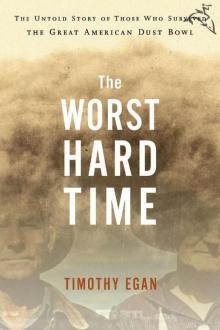 The Worst Hard Time: The Untold Story of Those Who Survived the Great American Dust Bowl
The Worst Hard Time: The Untold Story of Those Who Survived the Great American Dust Bowl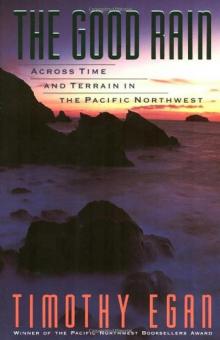 The Good Rain: Across Time & Terrain in the Pacific Northwest
The Good Rain: Across Time & Terrain in the Pacific Northwest Breaking Blue
Breaking Blue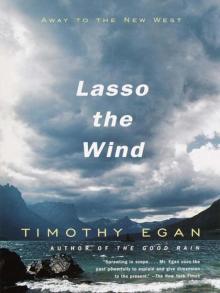 Lasso the Wind: Away to the New West
Lasso the Wind: Away to the New West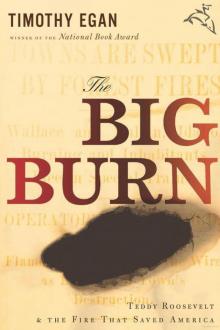 The Big Burn: Teddy Roosevelt and the Fire That Saved America
The Big Burn: Teddy Roosevelt and the Fire That Saved America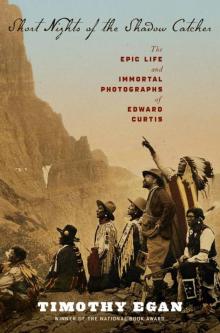 Short Nights of the Shadow Catcher
Short Nights of the Shadow Catcher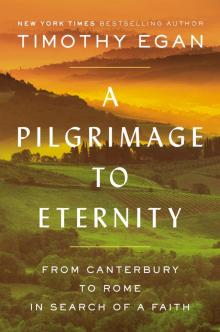 A Pilgrimage to Eternity
A Pilgrimage to Eternity The Worst Hard Time
The Worst Hard Time The Big Burn
The Big Burn